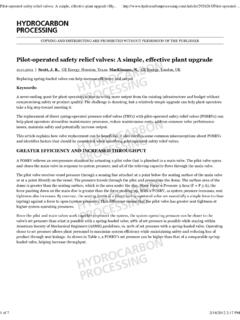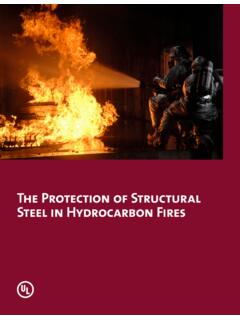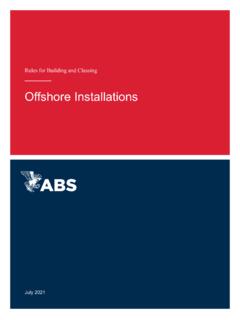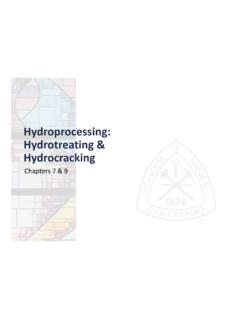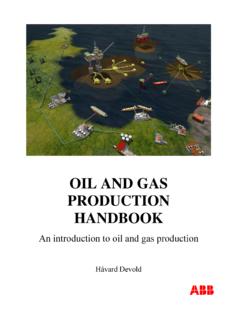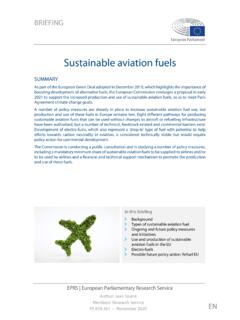Transcription of Natural Gas Flaring and Venting: State and Federal ...
1 1 Natural GAS Flaring AND VENTING: State AND Federal REGULATORY OVERVIEW, TRENDS, AND IMPACTSN atural Gas Flaring and Venting: State and Federal Regulatory Overview, Trends, and ImpactsJune 2019 Office of Oil and Natural GasOffice of Fossil EnergyiNATURAL GAS Flaring AND VENTING: State AND Federal REGULATORY OVERVIEW, TRENDS, AND IMPACTSE xecutive SummaryThe purpose of this report by the Office of Fossil Energy (FE) of the Department of Energy (DOE) is to inform the states and other stakeholders on Natural gas Flaring and venting regulations, the level and types of restrictions and permissions, and potential options available to economically capture and utilize Natural gas, if the economics warrant. While it is unlikely that the Flaring and limited venting of Natural gas during production and handling can ever be entirely eliminated, both industry and regulators agree that there is value in developing and applying technologies and practices to economically recover and limit both practices.
2 FE s objective is to accelerate the development of modular conversion technologies that, when coupled with the currently available commercial alternatives, will provide a complete portfolio of options for companies seeking to monetize flared gas volumes of practically any magnitude and at any location. Natural gas is a gaseous mixture of hydrocarbon compounds, the primary one being methane and non- hydrocarbon gases ( , water vapor, carbon dioxide, helium, hydrogen sulfide, and nitrogen). Natural gas Flaring is the controlled combustion of volatile hydrocarbons and venting is the direct release of Natural gas into the atmosphere, typically in small amounts. While Flaring is more common than venting, both of these activities routinely occur during oil and Natural gas development as part of drilling, production, gathering, processing, and transportation operations.
3 The reasons behind both Flaring and venting may be related to safety, economics, operational expediency, or a combination of all three. Both Federal and individual State regulations control the amount of Flaring and venting that is permitted, as described in the Analysis of State Policies and Regulations section of this , Flaring has become more of an issue with the rapid development of unconventional, tight oil and gas resources over the past two decades, beginning with shale gas. Unconventional development has brought online hydrocarbon resources that vary in their characteristics and proportions of Natural gas, Natural gas liquids and crude oil. While each producing region flares gas for various reasons, the lack of a direct market access for the gas is the most prevalent reason for ongoing Flaring . Economics can dictate that the more valuable oil be produced and the associated gas burned (or reinjected) to facilitate that production.
4 Until transmission, storage, and delivery infrastructure increases in these newer or expanding producing regions, Flaring and venting will continue to represent environmental issues and lost market opportunities. Of specific importance has been the increase in Flaring of gas associated with oil production in liquids rich plays where there is not enough gas gathering and transportation infrastructure to enable the gas to be marketed. Two states where Flaring has increased are Texas and North Dakota, while both states are working with producers to limit the need for Flaring without shutting down or impacting the timely and continued production of oil from new wells. In both cases, these states have seen rapid development of unconventional oil plays ( , Permian Basin and Eagle Ford in Texas and Bakken Shale in North Dakota) with significant volumes of associated gas production.
5 In 2017, the volumes of gas flared and vented reported to DOE s iiNATURAL GAS Flaring AND VENTING: State AND Federal REGULATORY OVERVIEW, TRENDS, AND IMPACTSE nergy Information Administration (EIA) by Texas totaled 101 billion cubic feet (Bcf ) and North Dakota by Bcf. These totals are 10 to 20 times the volumes reported by other states that collect such data and the numbers reflect the much higher level of oil and Natural gas production in these two states. Data on Flaring and venting volumes have been collected from producers by some producing State agencies, who then share the data with EIA. The data compiled by EIA show that the reported volumes of gas flared reached levels of between 225 and 285 Bcf per year in the mid-1990s. After dropping to less than half that during the early 2000s, reported flared volumes have again risen to levels between about 200 and about 300 Bcf per year during the 2011-2017 time period as both oil and Natural gas production levels have increased significantly.
6 Every oil- and gas-producing State has in place regulations to limit or prevent the waste of gas resources. However, the Flaring limits vary from State to State and no national standards currently exists. FE has developed a series of individual State fact sheets that summarize the Flaring and venting regulations applicable in each of 32 oil- and gas-producing states and provide context and contact information for interested stakeholders. These fact sheets will be available on FE s the states where a large number of associated gas flares have been permitted over the past few years, planned increases in Natural gas processing and pipeline takeaway capacity may reduce the volume of Flaring over the next five years. In both Texas and North Dakota, gas processing and gas pipeline capacities are being expanded to handle the increased volumes of associated gas being produced so that it can be economically captured and sold.
7 In the short term, however, Flaring percentages have the potential to rise above current levels in both Texas and North Dakota if oil prices continue to recover and drilling rigs remain active. Many companies have implemented technology solutions to venting voluntarily or in response to regulations, although continued increases represent losses to valuable economic resources and sources for emissions. Technologies currently exist to capture gas that would otherwise be flared and convert it into useful products, or used onsite to facilitate production. Opportunities exist to increase the prevalence of these technological solutions and improve their economical uses, ultimately benefiting domestic and international gas consumers. Commercial alternatives to Flaring include compressing Natural gas and trucking it short distances for use as a fuel for oil field activities; extracting Natural gas liquids from the flare gas stream before Flaring the remaining methane (a partial solution); converting the gas to electric power using small-scale generators, small-scale gas-to-methanol or gas-to-liquids conversion plants; and converting captured gas to LNG and trucking it short distances for use as a fuel for oil field is currently implementing a plan to expand its research program focused on mitigating emissions from midstream Natural gas infrastructure.
8 One of the areas of interest is focused on accelerating the development of technologies capable of converting gas that would otherwise be flared, into transportable, value-added products. It is envisioned that successful technologies developed in this research and development effort will be integrated into small-scale modular systems that, in the future, can be transported from one flare site to the next for use during periods when planned Natural gas gathering and transportation systems are not yet is specifically targeting two areas where basic research needs have been identified: (1) multifunctional catalysts, and (2) modular conversion equipment designs. The first area involves the early-stage development and evaluation of multifunctional catalysts for the direct conversion of methane to liquid petrochemicals ( , methanol, ethanol, iiiNATURAL GAS Flaring AND VENTING: State AND Federal REGULATORY OVERVIEW, TRENDS, AND IMPACTS ethylene glycol, acetic acid, and other hydrocarbons) that can be easily transported and are suitable for subsequent conversion into commercial products.
9 The second area of interest is the development of novel equipment and process design concepts for achieving high-selectivity pyrolysis, which is integral to the manufacture of high-value carbon products from methane or the mixtures of methane, ethane, propane, and butanes representative. Research in this area will focus on the application of process intensification at modular-equipment scales suitable for deployment and transport between remote locations where gas is being to Natural ivNATURAL GAS Flaring AND VENTING: State AND Federal REGULATORY OVERVIEW, TRENDS, AND IMPACTST able of ContentsExecutive to Natural Gas Flaring and Venting ..iiiFlaring and Venting Definitions ..1 Flaring and Venting Volume Estimates ..6 Federal Flaring and Venting Regulations ..15 Overview of Federal Policy ..17 Current and Pending Federal Regulatory Actions on Natural Gas Flaring and Venting.
10 17 Assess Potential Federal Impediments to Oil and Natural Gas Production ..19 Analysis of State Policies and Regulations ..20 Summary of Impacts and Trends ..20 Projected Associated Gas Production ..49 Technology Solutions to Reduce Associated Natural Gas Flaring and Venting ..50 DOE Initiatives to Accelerate Technology Solutions to Reduce Natural Gas Flaring and Venting ..53 Conclusions ..55 Appendix A: Analysis of Texas Railroad Commission Flare Data ..561 Natural GAS Flaring AND VENTING: State AND Federal REGULATORY OVERVIEW, TRENDS, AND IMPACTSI ntroduction to Natural Gas Flaring and VentingFlaring and Venting DefinitionsNatural gas Flaring is defined as the controlled combustion of Natural gas for operational, safety, or economic reasons. Venting is the direct release of Natural gas into the atmosphere. Categories of Natural gas Flaring and venting in the upstream oil and Natural gas industry include the following:1.











